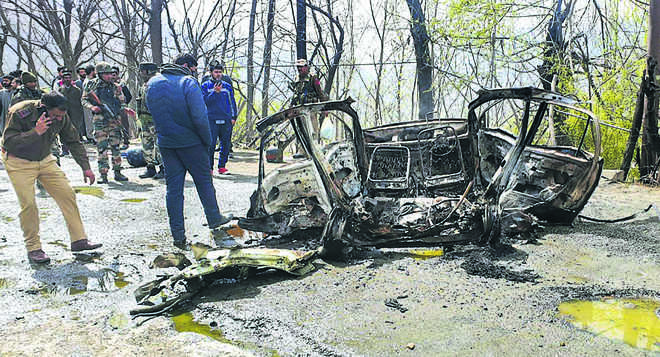
WORRYING: A new generation of young Kashmiris has been radicalised to associate itself with trans-national radical trends.
Lt Gen Syed Ata Hasnain (retd)
former GOC, 15 Corps, Kashmir
THE attempt to blow up another CRPF bus through a car-borne suicide bomber comes much earlier than estimated. It has been my steadfast belief that the era of improvised explosive devices (IEDs) and car bombs would return with a vengeance to Kashmir, their effect having been witnessed in internal hybrid conflicts of Syria, Iraq, Pakistan and Afghanistan. As the usage got more vicious and there were no qualms about the choice of targets, this unethical tool of organised violence found more and more takers, leading to its comeback in Kashmir.
The latest attempt was almost a repeat of the Pulwama attack on February 14, except for the location, which was just south of the Pir Panjal range at Banihal. Owais Amin, a 20-year-old Kashmiri from Shopian, has been arrested for the attempt which went awry when he tried to ram the car fitted with IEDs (improvised explosive devices) into the CRPF bus. At least one IED or a gas-filled cylinder caught fire and probably did not explode, but reduced the car to ashes. Amin escaped in the melee, but was apprehended later by the J&K Police while attempting to sneak back into the Valley.
Those who have been involved in searches for IEDs in J&K in the 1990s and the early 2000s would vouch for the complexities in their fabrication in local houses and subsequent deployment on roads and country lanes. These are not simple demolition sets which people may imagine; these involve more than just the explosive, detonator, fuse wire and switch. Upgrade that to the level of a car bomb and a suicide bomber and it becomes even more dangerous to handle before it detonates. The work involving fabrication of such a car bomb is usually delegated to what are called ‘IED doctors’; one of them involved in the Pulwama incident was later cornered and killed by the Army within 100 hours of the occurrence. There are probably a couple of such ‘doctors’ in the Valley, trained by the Pakistani deep state. The spectre of radicalisation is helping in finding recruits such as Owais Amin and Adil Ahmad Dar (Pulwama bomber). It appears that the effects of what Pakistan planned over many years as part of the Zia doctrine are now beginning to have greater impact. A new generation of young Kashmiris has been radicalised sufficiently to associate itself with trans-national radical trends, something we earlier perceived as unlikely. Ironically, as the international trends are waning, a surge is appearing in Kashmir.
The near miss by Owais Amin has not been owned up by any terror group so far and will unlikely find ownership due to the botched attempt or simply due to a chiding the deep state may have given the Jaish-e-Mohammad (JeM) for putting it in a spot. Can we therefore expect a repeat of such attempts in the coming days? The assumption should surely point towards greater possibility. A couple of reasons for this can be identified. First, the General Election in India diverts the attention of intelligence agencies at all levels. Second, the resultant impact at such a time creates more confusion in response and far more antipathy among the public, which is getting more restive by the day. Third, the Pakistani leadership appears fairly gung-ho about the impact of the Pulwama attack and perceives that it weathered the storm of India’s response. Internationally, while there has been a furore, Pakistan probably perceives that it has escaped international opprobrium. Ayesha Siddiqa, noted Pakistani author and commentator, writes: “The understanding in Pakistan is that the post-Pulwama situation has actually worked to its advantage — or is a stalemate. The situation today is comparable to the Rann of Kutch operation in 1965, or the 1965 war. As far as the diplomatic war is concerned, that will be long and protracted.” It is this perceived advantage that spells the dangers of more threats in Kashmir, and not from car bombs alone. Innovative ways of beating the Indian intelligence agencies will be the aim and intent, with maximum impact sought. A misconceived notion seems to exist in Pakistan that India is tied in knots and even serious analysts like Ayesha Siddiqa seems to be swayed by it. There appears to be a fair misreading of India’s military capabilities due to our more than transparent discussions on national media about an existing hollowness. The reported communication by India’s National Security Adviser (NSA) to his US counterpart on February 27 that India may not hold back if the captured IAF pilot was ill-treated and the move of some surface-to-surface missile batteries spells a level of seriousness which Pakistan does not appear to take at face value. Pakistan’s introspection on its ability to wage war against India, given the state of its economy, should force it to desist from any further risk. However, the irrationality and ‘hara-kiri’ approach, without examining the terminal end of actions it initiates, continues to create an impasse which may hurtle the subcontinent towards a war-like situation earlier than ever contemplated before. A lot would depend on what China advises the Pakistani leadership, having just bailed it out of yet another imminent bankruptcy. Also, much would depend on PM Imran Khan’s ability to resist the Generals whose gung-ho attitude and misplaced confidence now needs to be factored even more in India’s appreciation of future security scenarios.
While Indian intelligence agencies have done a creditable job and the Pulwama incident was not something easily avoidable, it is going to be difficult to defend them in the event of more such acts by pro-Pakistan elements in Kashmir or elsewhere. India’s diplomatic efforts must remain at a high pitch not for any other reason but to convey the seriousness with which India looks at the developing situation in the subcontinent. Pakistan appears to have pinned far too many hopes on its nuclear basket. Our unwillingness not to speak about our own nuclear capability may be misconstrued by our adversary.
Perhaps it is time to do what former Army Chief General Padmanabhan did in early 2002 — the conveyance of a message in no uncertain terms. Getting Pakistan to a state of full military mobilisation will cost it dear and put the international community on tenterhooks. India can no longer sit and await being hit by the next spectacular event that Pakistan has planned. An escalation this time will probably mean war and Pakistan can only do lip service to its capability to withstand the Indian military might.



























